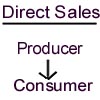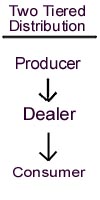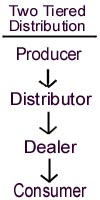![]()
![]()
Marketing Survival Newsletter - Distribution Channels
In our last newsletter I talked about building an E-commerce site, and how the web was growing. Most industry experts have been projecting billions and billions of dollars in E-commerce in the coming years. In 1998 all E-commerce sites did $1.7 billion in holiday sales. 2000 holiday sales were approximately $4 billion. That is a 236% increase in sales. Since then, thousands of E-commerce sites have been added to the Internet, and Millions of Dollars, Pounds, Yen, Francs and other currencies have been spent on advertising E-commerce sites.
This may sound good, but if you consider that the number of sites, and amount of advertising is probably 1000% to 10,000% greater than last year, it isn’t very impressive. It is also good to know that even with this 236% increase, web sales still represent less than 1% of total holiday spending. Now, I understand that customers will have to get used to buying over the Web, and there is a lag time between marketing and sales, but for most of us (who are small fish in a very large pond) this is a very good reality check. This is a reminder that can save us from putting all our marketing resources in the wrong investment. In other words, this reemphasizes the need for a diversified marketing plan. As I said in my earlier newsletter, "The web site is not a single solution to marketing/sales". It does not replace conventional marketing. It is part of an overall marketing program. If we keep this in mind, an E-commerce web site can be a valuable asset in an overall marketing program.
DISTRIBUTION CHANNELS
Now I will do a 180 degree turn to distribution channels. Some of my clients are AC/DC, cross overs, yes - you have it – they are both developers and resellers. As I work with them I am hearing the plight of the reseller in today’s market. With the advent of the Internet, direct sale is becoming the wave of the future for many producers, and this means a significant change for resellers and distributors around the world.
Although I understand and in many cases appreciate these changes, I still believe there is a place for the reseller in technical software distribution, and I believe this change may open some opportunities for both developers and resellers.
HISTORY
In the early days of computers, distributors/dealers made their profit by selling hardware, and bundling software as an add-on to the sale. The profit was in the hardware, the software was often superfluous to the sale. Today, hardware and some platform software, have become very low margin commodities. In fact, some primary platform providers, such as Autodesk, are gradually reducing the size of their reseller channel. This may mean that resellers are forced to look at third party products that provide a true value-add as a way of reaching clients, and as an introduction to selling additional products, and services, such as technical support, customization, and training.
This shift in focus means that some technical applications formerly locked out of the distribution channel, can now find warmer reception in the traditional distributor/dealer channel. The trick for both the developer and dealer is to understand how the channel works, what resellers are looking for, and how each application fits into that formula. Additionally, it is important to understand what distribution types work best for what products.
Deciding which distribution style is best for a product is partly a function of price, market demographic, and user requirements. The remainder of this article looks at each distribution type, where they are best suited, and how they benefit the producer and distributor/dealer.
Direct Sales
| Under a Direct Sales distribution concept the producer sells directly to
the consumer. Some of the primary determining factors in choosing Direct Sales are: |
 |
As you can see from this brief list, the main requirement is that it be an easy sale. The user must be able to identify the benefits quickly and easily, and the product must require little or no training and support. Also, the price must be in a range that I call the "no-brainer" range. In other words, the end-user must be able to make a buying decision without much thought. That always requires a very favorable benefit-to-price ratio, which means high benefit and low price.
Another factor relating to lower priced products is that most products priced under the $500 to $700 range are not profitable enough for many distributors or dealers to handle. Although we are not dealing with product pricing strategies in this article, this is one of the factors that must be considered in establishing a price point for a product. The fact is that, because of a low price point, the only distribution channel available for many products is Direct Sales.
Multi-tiered distribution
Although many programs are best suited for Direct Distribution, there are many situations in which a multi-tiered distribution network can better fit the needs of both the producer and end user. Specific situations are:
Two –tiered distribution
There are two basic types of multi-tiered distribution channels – two tiered, and three tiered distribution. Two tiered distribution is where the producer sells directly to a dealer channel, and the dealers sell directly to the end user. This form of distribution usually requires:
|
 |
As you can see from this brief list, the producer maintains responsibility for managing the production of the product, managing marketing, and for managing the distribution channel. The dealer is responsible for selling to a limited regional end user base.
The two tiered distribution channel works well in situations where the product is very technical, requires face-to-face sales, or is support/training intensive. Local or regional dealers are almost always in a better position then the producers to provide hands on sales and support.
Both the dealer and producer should also anticipate higher product prices for multi-tiered distribution channels when compared to direct channels. The higher end-user price is required to support the discount offered the dealer, the additional costs of management of the dealer channel, and the cost of marketing to both the end user and the dealer channel.
It should be noted that two-tiered distribution is most desirable in local markets, where the producer can have direct contact with the dealer channel.
Three-tiered distribution
While Direct and Two-Tiered channels are very effective for domestic sales and marketing activities, three-tier distributor channels are most effective in situations where the producer wishes to, or must be, removed from the marketing and management activities within a specific market. This is most important in foreign markets where distance, customs, localization, and language alienate the producer, and require a local manager. For example, if a product is produced in Germany, but the market is in Australia, who handles the localization, marketing, support, training, etc.? In order for the producer in Germany to manage these activities they must open an office in Australia, hire local personnel, and build an organization. In other words, they must become their own distributor. This is not very cost effective for most developers. So, the solution is ---find a local distributor to build the dealer channel, and manage marketing, sales, support, and training. |
 |
This form of distribution usually requires:
In the three-tiered distribution style the developer is letting go of a significant amount of responsibility, in return for a significant discount on the price of the product. For this reason both the producer and the distributor must take every precaution in selecting and negotiating their working partnership. Over time, both parties will invest significant resources in bringing the product to market. If the relationship does not work, both parties will not only lose the resources invested, but also the time invested in the failed effort. The time and money spent in insuring compatibility of product lines, customer types, and organizational management styles will be returned many times over in the course of the future business relationship.
Alternative Distribution Styles
Although I have identified only three distribution types, it should be noted that there are many variations on these three basic types. Some companies have found manufacturers representatives to be an effective sales vehicle, others have found a single dealer who effectively acts as both a dealer and distributor selling to both other dealers and end users, still others license their products to other producers to bundle with their products (OEM agreements). Some companies use management organizations located near or in the market to manage their marketing and/or distribution in that country or region, and others use a management group to build a market, and then build the Two-Tiered or Three-Tiered distribution channel. Whatever the choice, the fundamental concepts we have discussed still apply.
The key is first doing your ground work – research. Learn a little about the market you are entering, and then study the local distribution channels. With a little research you will begin to discover the distributors, dealers, representatives or management organizations that are operating in that region. Then investigate them. Make sure you are dealing with organizations that have experience, good reputations, and qualified staff. Talk to them, make sure you are able to communicate clearly and comfortably with them. Then, ask yourself if you want them as your partner, because that is exactly what they become if you make them your dealer, distributor, or market representative or manager. These comments are equally true for the distributor. Before selecting or accepting a product to distribute, the distributor should perform the same level of careful research. Finally, if everything looks positive, move ahead with a commitment to long term success.
Building good distribution channels can be hard work, but at the same time very rewarding. On our web site there is an expanded version of this article, and several past articles that may help with your efforts in this area. There is also a report specifically dealing with the E-commerce market, and building an E-commerce web site. You are welcome to log on and down load any of these articles at no cost from our Marketing Survival Newsletter web site. Or, if you have questions, call us at 503-262-9974 and arrange for a free 30 minute consultation. I am happy to discuss your specific situation with you.
I make regular trips to Europe to introduce products and help build distribution channels for clients. If you are interested in having your product or application distributed in Europe, please contact us for more information.
~Nick Vasilieff
This newsletter was written by Nickolai N. Vasilieff; freelance writer and marketing consultant specializing in high technology industries.
For more information see www.nvasilieff.com. To contact Nick with questions or feedback, call 503-267-6339 or email vasilieff@mac.com.
Return to© Copyright 2009 Third Party International. All Rights Reserved.